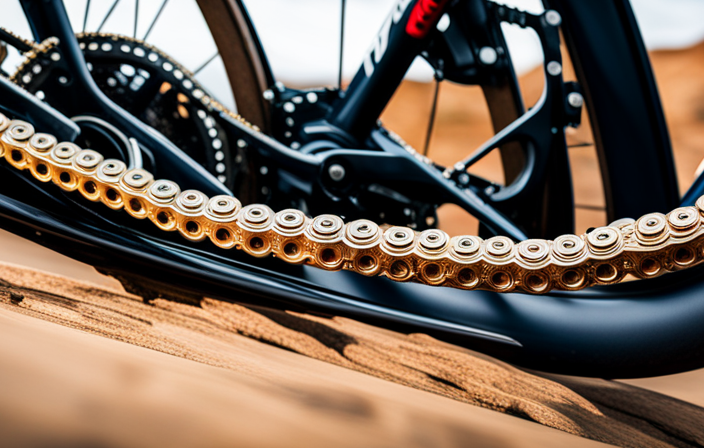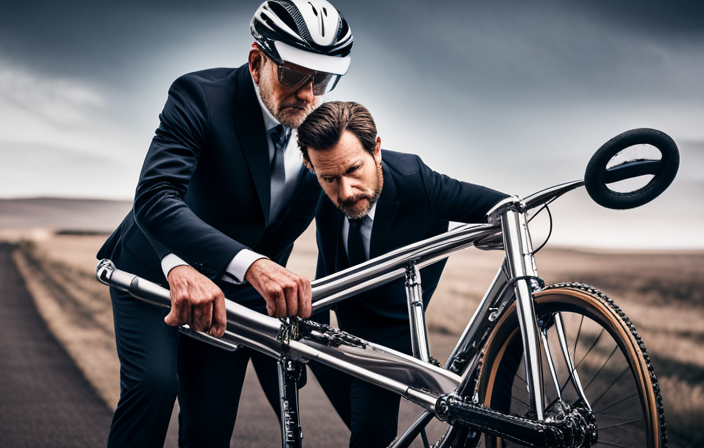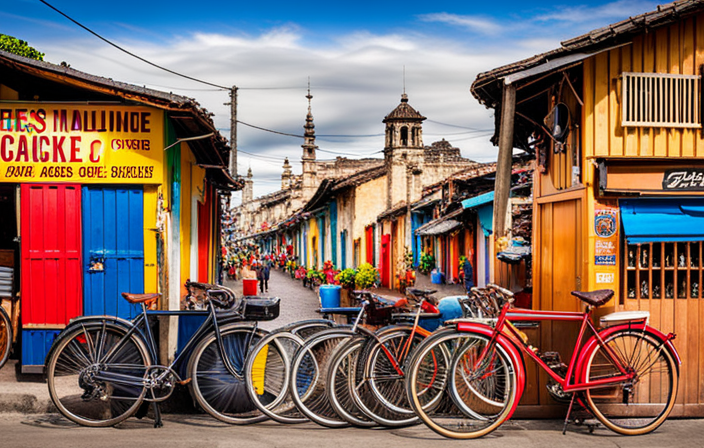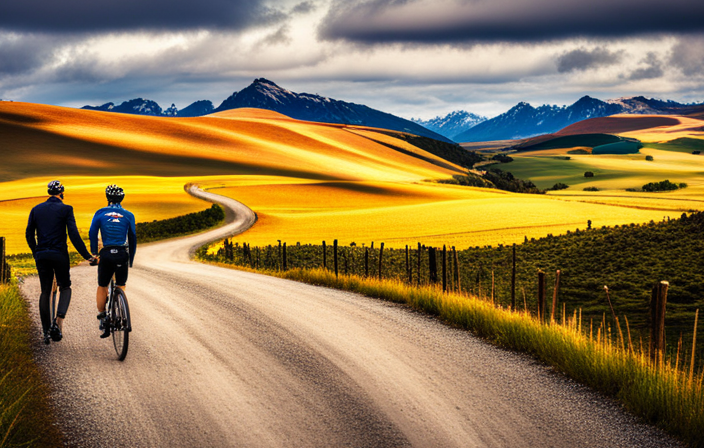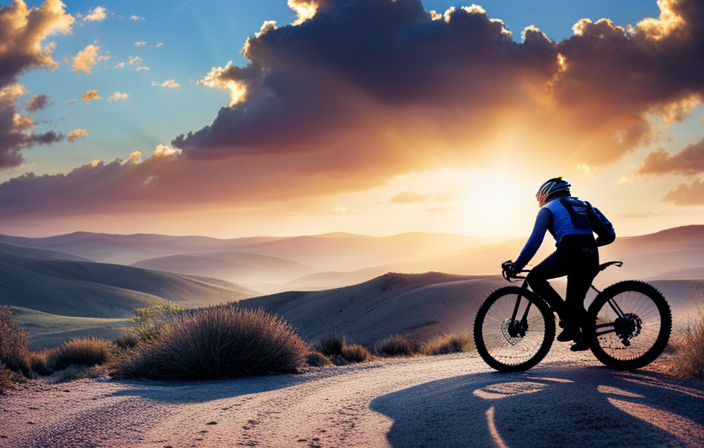As an experienced gravel cyclist, I have learned the importance of chain lubrication in improving efficiency and prolonging the life of my bike. With numerous choices on the market, it is crucial to select the appropriate chain lube for your gravel bike.
In this article, I’ll explore the importance of selecting the appropriate lubricant, discuss different types of chain lubricants specifically designed for gravel biking, and provide recommendations along with application and maintenance tips.
Get ready to elevate your gravel biking experience with the perfect chain lube.
Key Takeaways
- Choosing the right chain lube for gravel biking is crucial for bike performance and lifespan.
- Gravel biking exposes the chain to more dirt and debris, making proper chain maintenance even more important.
- Factors to consider when choosing chain lube include durability, performance in various weather conditions, and resistance to dirt and grime.
- Wet lubes and dry lubes are available for different riding conditions, and it’s important to choose based on personal preference and riding conditions.
Importance of Choosing the Right Chain Lube for Gravel Biking
You need to make sure you’re using the right chain lube for gravel biking, as it can greatly affect your bike’s performance and overall ride experience. When it comes to riding on gravel, your chain is exposed to more dirt, dust, and debris than when riding on paved roads. This means that proper chain maintenance is crucial.
One of the main considerations for chain lubrication in gravel biking is choosing a lube that provides excellent dirt and dust resistance. Gravel-specific lubes are designed to create a protective barrier on your chain, preventing particles from sticking and causing friction. This not only helps to prolong the life of your chain but also ensures smooth shifting and efficient power transfer.
Proper chain maintenance has numerous benefits for gravel bikers. Firstly, it reduces wear on the drivetrain components such as the cassette and chainrings, saving you money in the long run. Secondly, a well-lubricated chain improves overall efficiency by minimizing energy loss through friction. Lastly, using the right lube can help keep your drivetrain quiet and smooth while reducing the chances of annoying squeaks or creaks.
Considering these factors for gravel bike chain lubrication will ensure optimal performance during your rides. Now let’s delve into some key considerations when selecting the right lube for your gravel bike’s chain without skipping a beat.
Considerations for Gravel Bike Chain Lubrication
When it comes to gravel bike chain lubrication, there are several key considerations that I always keep in mind.
Firstly, durability and longevity are crucial factors to consider as we put our bikes through tough terrains and challenging conditions.
Secondly, the performance of the chain lube in various weather conditions is important for maintaining smooth and efficient pedaling.
Lastly, resistance to dirt and grime is a must-have feature to ensure that the drivetrain remains clean and free from any potential damage.
By carefully considering these aspects, I can make an informed decision on which chain lube will best suit my needs for gravel biking adventures.
Durability and Longevity
For optimal durability and longevity, consider using a chain lube that is specifically designed for gravel bikes. These specialized lubes are formulated to withstand the harsh conditions of off-road riding, providing superior protection against dirt, dust, and moisture.
When choosing a chain lube, it’s important to strike a balance between longevity and performance. Some lubes may offer exceptional durability but sacrifice on overall performance, while others may excel in terms of effectiveness but come at a higher cost.
To help you make an informed decision, here are two factors to consider:
- Longevity vs. Performance:
- Look for a chain lube that offers both long-lasting lubrication and excellent performance on the trails.
- Consider the trade-off between how long the lube will last before reapplication versus its ability to keep your drivetrain running smoothly.
By selecting the right chain lube for your gravel bike, you can ensure optimal durability and longevity while also maintaining top-notch performance in various weather conditions.
Performance in Various Weather Conditions
To maximize your riding experience, it’s important to consider how well the lubrication performs in different weather conditions. When it comes to chain lubes for gravel bikes, performance in extreme temperatures is crucial. Whether you’re riding under scorching heat or freezing cold, the right lube can make a significant difference.
A high-quality chain lube will maintain its effectiveness even in the harshest conditions, ensuring smooth and efficient shifting throughout your ride.
Furthermore, the impact of chain lube on shifting accuracy cannot be overlooked. In wet and muddy conditions, a good chain lube will prevent dirt and grime from building up on your drivetrain, minimizing friction and maintaining precise gear changes. This not only enhances your overall performance but also prolongs the life of your components.
Transitioning into the subsequent section about resistance to dirt and grime, it is essential to choose a chain lube that provides excellent protection against these elements without compromising performance.
Resistance to Dirt and Grime
A high-quality lubricant will effectively resist dirt and grime, ensuring a clean and smooth ride. When it comes to riding on gravel, the chain is constantly exposed to dust, mud, and other debris that can accumulate and cause friction. That’s why it’s crucial to choose a chain lube that offers resistance to water and provides effective protection against rust.
A good gravel bike chain lube will create a barrier between the chain and any moisture or dirt that may come into contact with it. This barrier not only keeps the chain cleaner for longer but also reduces wear and tear caused by grit grinding against the metal surfaces.
As we move forward into discussing types of chain lubricants for gravel biking, let’s explore how different formulas cater to specific needs and conditions without compromising performance.
Types of Chain Lubricants for Gravel Biking
There’s a variety of chain lubricants available for gravel biking. When it comes to choosing the right one, there are a few considerations to keep in mind.
One important factor is the type of riding you’ll be doing. If you’re tackling muddy and wet terrains, you’ll need a lube that offers excellent resistance to dirt and grime. This will help prevent buildup on your chain and ensure smooth shifting.
Another consideration is the viscosity of the lubricant. Thicker lubes tend to last longer but can attract more dirt, while thinner lubes may require more frequent applications but offer better penetration into the chain’s links.
Now let’s talk about some recommended chain lubricants for gravel biking. One popular option is a wet lube, which provides superior protection in wet conditions. It forms a durable coating on your chain that repels water and prevents rusting. Dry lubes, on the other hand, are great for dusty environments as they create a dry film that doesn’t attract dirt.
In conclusion, choosing the right chain lube for gravel biking depends on factors such as riding conditions and personal preference. Considerations like resistance to dirt and grime and viscosity play an important role in making your decision easier.
Now let’s dive into some recommended chain lubricants for gravel biking without wasting any time.
Recommended Chain Lubricants for Gravel Biking
If you want optimal performance on your rides, consider using a wet or dry lubricant specifically designed for off-road conditions. The right chain lubricant is essential for gravel biking because it helps reduce friction and wear on the drivetrain components, ensuring smooth shifting and efficient power transfer. When it comes to choosing the top chain lubricants for off-road riding, there are a few options that stand out.
One highly recommended option is the Finish Line Ceramic Wax. This dry lubricant provides excellent dirt and dust repellency, keeping your chain clean in even the muddiest conditions. It also offers long-lasting performance, reducing the need for frequent reapplication.
Another great choice is the Muc-Off C3 Ceramic Dry Lube. This lube features a unique ceramic formulation that provides ultra-low friction, enhancing overall efficiency. It also boasts superb durability and repels water effectively.
For riders who prefer wet lubes, the Rock-N-Roll Gold Chain Lubricant is an excellent option. Its high viscosity formula ensures long-lasting protection against dirt and grime while providing smooth and quiet operation.
In conclusion, choosing the right chain lubricant is of utmost importance when it comes to gravel biking. The Finish Line Ceramic Wax, Muc-Off C3 Ceramic Dry Lube, and Rock-N-Roll Gold Chain Lubricant are all top choices for off-road riding due to their exceptional performance in harsh conditions.
Transitioning into the next section about application and maintenance tips for gravel bike chain lubrication…
Application and Maintenance Tips for Gravel Bike Chain Lubrication
To ensure optimal performance and durability, it’s important to properly apply and maintain the lubrication on your gravel bike chain. Here are some application techniques and common chain lube mistakes that I have learned through my experience:
-
When applying the chain lube, make sure to clean the chain thoroughly beforehand. Use a degreaser or warm soapy water to remove any dirt or grime.
-
Apply the lube evenly along the entire length of the chain while rotating the pedal backwards. This ensures that all parts of the chain are properly covered.
-
After applying the lube, give it some time to penetrate into the inner workings of the chain before wiping off any excess. This helps prevent attracting dirt and prolongs the life of your drivetrain.
Common mistakes to avoid when lubing your gravel bike chain include:
-
Over-lubricating: Applying too much lube can attract dirt and create a messy buildup on your drivetrain.
-
Under-lubricating: Failing to apply enough lube can lead to increased friction and wear on your chain.
By following these application techniques and avoiding common mistakes, you can ensure that your gravel bike’s chain is properly lubricated for optimal performance.
Now let’s move on to other factors to consider for gravel bike performance such as tire pressure and gear ratios.
Other Factors to Consider for Gravel Bike Performance
When it comes to maximizing gravel bike performance, there are several other factors to consider aside from chain lubrication.
Proper chain tension is crucial for efficient power transfer and preventing excessive wear on the drivetrain.
Regular bike maintenance is essential to keep all components in optimal condition and avoid unexpected mechanical issues on the trail.
Choosing the right gear ratios will ensure you have the appropriate range of options for different terrains, while tire selection plays a significant role in grip, rolling resistance, and puncture protection.
Lastly, making suspension and tire pressure adjustments can greatly improve comfort and traction on rough gravel surfaces.
Proper Chain Tension
Make sure you maintain the proper tension of your chain to prevent any issues while riding your gravel bike. Here are three key reasons why proper chain tension is essential:
-
Proper chain tension helps optimize power transfer: When the chain is too loose, power can be lost as it slips on the teeth of the gears. On the other hand, an overly tight chain can increase friction and impede pedaling efficiency.
-
Prevents excessive wear on drivetrain components: If the chain is too loose, it can bounce and slap against the derailleur or chainstay, causing premature wear. Conversely, an overly tight chain increases stress on both the cassette and chainrings.
-
Ensures accurate shifting: Properly tensioned chains facilitate smooth and precise gear changes by providing consistent engagement with the teeth of the gears.
Maintaining proper chain tension is just one aspect of regular bike maintenance that contributes to a smooth and enjoyable riding experience without compromising performance.
Regular Bike Maintenance
Ensure you regularly maintain your bicycle to keep it in optimal condition for a smooth and enjoyable riding experience. Regular bike maintenance is essential for the longevity and performance of your gravel bike.
One important aspect of maintenance is chain cleaning. Over time, dirt, debris, and grime can accumulate on your chain, leading to decreased performance and potential damage. To prevent this, I recommend using a degreaser specifically designed for bikes to remove any built-up residue.
After cleaning, make sure to lubricate the chain with a high-quality chain lube suitable for gravel riding. This will ensure smooth shifting and reduce friction between moving parts.
By incorporating regular chain cleaning techniques into your maintenance routine, you can extend the life of your drivetrain and maximize performance on the trails or roads ahead.
Now let’s dive into choosing the right gear ratios…
Choosing the Right Gear Ratios
To optimize your riding experience, it’s important to select the appropriate gear ratios for your bicycle. Gear ratio selection plays a crucial role in determining how efficiently you can pedal and maintain a comfortable cadence on different terrains. When choosing gear ratios, consider factors such as the type of terrain you’ll be riding on, the gradient of the roads or trails, and your own fitness level.
For gravel riding, it’s recommended to have a wider range of gears compared to road cycling. This allows you to easily tackle steep climbs and navigate through loose gravel sections without straining too much. Opting for lower gear ratios will provide better power transfer and make it easier to climb hills with reduced effort.
Now that we’ve covered gear ratio selection, let’s move on to discussing tire selection for gravel riding without missing a beat.
Tire Selection for Gravel Riding
When riding on gravel, it’s important to choose the right tires to ensure optimal performance and control. Tire pressure management is crucial for a smooth and comfortable ride on uneven terrain.
For gravel riding, I recommend using wider tires with lower pressure to increase traction and absorb shocks. The wider tire width provides more stability and reduces the risk of getting stuck in loose gravel or sliding on corners. It also allows for better control when navigating through rough patches or bumps.
However, it’s essential to find the right balance between tire width and pressure to avoid excessive rolling resistance or pinch flats.
In the next section about suspension and tire pressure adjustments, we will dive deeper into optimizing your bike setup for an enjoyable gravel riding experience without compromising comfort or speed.
Suspension and Tire Pressure Adjustments
For a smoother and more comfortable ride, you’ll want to make sure your bike’s suspension and tire pressure are properly adjusted. Suspension setup plays a crucial role in absorbing bumps and vibrations on rough gravel roads. It allows you to maintain control and reduces fatigue during long rides. Adjusting the suspension will depend on your weight, riding style, and terrain conditions. To optimize tire traction, it’s important to find the right tire pressure. A higher pressure provides better rolling efficiency on smooth surfaces but sacrifices grip on loose gravel. Conversely, lower pressures increase traction but may lead to increased rolling resistance. Finding the sweet spot requires experimentation and fine-tuning based on personal preference and riding conditions.
| Suspension Setup | Tire Pressure |
|---|---|
| Weight | Terrain |
| Riding Style | Personal Preference |
Ensuring both suspension and tire pressure are dialed in will significantly enhance your gravel bike experience by improving comfort, control, and overall performance.
Next section: Conclusion – Enhance your gravel bike experience with the right chain lube…
Conclusion: Enhance Your Gravel Bike Experience with the Right Chain Lube
Enhancing your gravel bike experience with the right chain lube is crucial. Not only does it improve bike efficiency, but it also prevents chain wear, ensuring a smoother and more enjoyable ride. After all, a well-lubricated chain means less friction, which translates to better power transfer and increased speed.
To make the most out of your gravel biking adventures, here are four essential factors to consider when choosing the right chain lube:
-
Durability: Look for a chain lube that can withstand the harsh conditions of off-road riding. Gravel bikes often encounter dust, dirt, and water splashes, so opt for a lube that provides long-lasting protection.
-
Low Friction: Find a chain lube specifically designed to reduce friction and resist contaminants like grit or sand. This will ensure smooth pedaling and prevent premature wear on both the chain and drivetrain components.
-
Easy Application: Choose a chain lube that is easy to apply without making a mess. A convenient applicator bottle or drip nozzle can simplify the process and save you time.
-
Longevity: Consider how frequently you ride your gravel bike before selecting a chain lube. Some lubes require more frequent reapplication than others, so choose one that suits your riding style and maintenance preferences.
By carefully selecting the right chain lube for your gravel bike, you can enhance its performance while prolonging its lifespan – ultimately maximizing your enjoyment on every off-road adventure!
Frequently Asked Questions
Can I use the same chain lube for my gravel bike as I do for my road bike?
Yes, you can use the same chain lube for your gravel bike as you do for your road bike. However, it’s important to note that gravel biking puts your chain through unique challenges like dust, dirt, and water crossings.
To ensure optimal performance and longevity, I recommend using a specific chain lube designed for gravel biking. These lubes are formulated to provide better protection against contaminants and offer increased durability on rough terrain.
Following proper chain maintenance tips will keep your drivetrain in top shape.
How often should I apply chain lube to my gravel bike?
Chain lube is the lifeblood of my gravel bike, keeping everything running smoothly on those rough and dusty trails. But how often should I apply it?
Well, it depends on a few factors. Generally, chain lube can last for about 200-300 miles on a gravel bike. However, environmental conditions and riding style can affect its longevity.
Remember not to over-lube your chain though, as excess lube attracts dirt and grime, which can damage your drivetrain.
Can I use wax-based chain lube on my gravel bike?
I highly recommend using wax-based chain lube on your gravel bike. Wax-based lubes offer several advantages over traditional oil-based lubes for gravel biking.
Firstly, they provide better durability and longevity, ensuring your chain stays lubricated even in harsh conditions.
Additionally, wax-based lubes create a cleaner drivetrain by repelling dirt and grime.
When comparing the performance of wax-based chain lubes to dry chain lubes on gravel bikes, wax-based lubes generally offer smoother shifting and quieter operation.
Is it necessary to clean my chain before applying chain lube?
Before applying chain lube, it’s like preparing a canvas for a masterpiece. Cleaning your chain with a degreaser ensures the perfect foundation for smooth and efficient riding. It removes dirt, grime, and old lube residue that can hinder performance.
To maintain a clean chain on your gravel bike, regularly wipe it down after rides and use a brush or rag to remove any built-up debris.
Remember, a clean chain is essential for optimal biking experience.
Are there any specific chain lubes that are better for wet or muddy conditions when gravel biking?
The best chain lube for wet gravel conditions depends on personal preference and the specific conditions you will be riding in. There are several options available, each with their own pros and cons.
Wet lubes are specifically designed to handle moisture and provide excellent protection against rust and corrosion. They do tend to attract more dirt and require more frequent cleaning.
Dry lubes, on the other hand, repel dirt but may not last as long in wet conditions.
It’s important to choose a lube that matches your needs and riding environment.
Conclusion
In conclusion, choosing the right chain lube for your gravel bike is essential for enhancing your overall riding experience. By considering factors such as weather conditions, terrain, and personal preferences, you can select the most suitable lubricant.
Whether it’s a wet or dry condition, there are various types of chain lubes available that cater to different needs. Remember to regularly apply and maintain the lubrication to ensure optimal performance.
So, gear up with the right chain lube and embark on your gravel biking adventures with confidence and ease! Unleash the full potential of your gravel bike and conquer any trail that comes your way!
